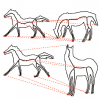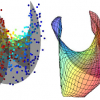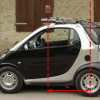114
Voted
ICCV
2009
IEEE
16 years 5 months ago
2009
IEEE
We present a shape-based algorithm for detecting and
recognizing non-rigid objects from natural images. The existing
literature in this domain often cannot model the objects
ver...
83
Voted
ICCV
2009
IEEE
16 years 5 months ago
2009
IEEE
We present a novel variant of the RANSAC algorithm
that is much more efficient, in particular when dealing with
problems with low inlier ratios. Our algorithm assumes
that there...
111
Voted
ICCV
2009
IEEE
16 years 5 months ago
2009
IEEE
We present a manifold learning approach to dimensionality
reduction that explicitly models the manifold as a mapping
from low to high dimensional space. The manifold is
represen...
106
click to vote
ICCV
2009
IEEE
16 years 5 months ago
2009
IEEE
We present a method to learn visual attributes (eg.“red”,
“metal”, “spotted”) and object classes (eg. “car”,
“dress”, “umbrella”) together. We assume imag...
ICCV
2009
IEEE
16 years 5 months ago
2009
IEEE
Fusing partial estimates is a critical and common problem
in many computer vision tasks such as part-based detection
and tracking. It generally becomes complicated and
intractab...
105
click to vote
ICCV
2009
IEEE
16 years 5 months ago
2009
IEEE
Random Forests (RFs) have become commonplace
in many computer vision applications. Their
popularity is mainly driven by their high computational
efficiency during both training ...
112
click to vote
ICCV
2009
IEEE
16 years 5 months ago
2009
IEEE
In this paper, we introduce a novel iterative motion tracking
framework that combines 3D tracking techniques with
motion retrieval for stabilizing markerless human motion
captur...
117
click to vote
ICCV
2009
IEEE
16 years 5 months ago
2009
IEEE
Face identification is the problem of determining
whether two face images depict the same person or not.
This is difficult due to variations in scale, pose, lighting,
background...
112
Voted
ICCV
2009
IEEE
16 years 5 months ago
2009
IEEE
Learning to cope with domain change has been known
as a challenging problem in many real-world applications.
This paper proposes a novel and efficient approach, named
domain ada...
108
Voted
ICCV
2009
IEEE
16 years 5 months ago
2009
IEEE
In structure-from-motion with a single camera it is well
known that the scene can be only recovered up to a scale. In
order to compute the absolute scale, one needs to know the
...






